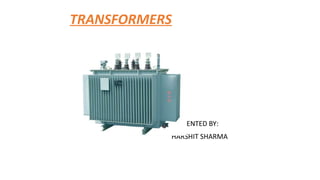
Transformers
- 2. CONTENTS • What is transformer? • History • Construction • Principle • Working • Types of transformers • Applications
- 3. One of greatest advantage of alternating current over direct current is that the alternating currents can be easily transferable from lowest voltage to high or high voltage to low voltage. . Alternating voltage can be raised or lowered as per requirements in the different stages of electrical network as Generation ,transmission, distribution and utilization. This is possible with a device known as transformer. INTRODUCTION
- 4. What is Transformer? ~ Transformer is a static device which transfers the electrical power or energy from one alternating current circuit to another with desired change in voltage or current and Without any change in the frequency. ~ There is no electrical contact between coils used ~ Transformers are used in our homes to keep voltage upto 220V ~ Transformer helping to form a safe Electric Power system is shown in Figure:
- 5. HISTORY In 1831, Micheal faraday and Joseph Henry independently gave the principle of transformer in the form of electromagnetic induction showing: where ε is the magnitude of the EMF in volts and ΦB is the magnetic flux through the circuit in webers The first type of transformer for wide use was the induction coil, invented by Rev. Nicholas Callan of Maynooth College, Ireland in 1836. Between the 1830s and the 1870s, efforts to build better induction coils, mostly by trial and error, slowly revealed the basic principles of transformers.
- 7. It consists of an iron core on which two separate coils of insulated copper wire are wound. The Coil to which A.C power voltage is supplied is Primary Coil. The Coil to which this power is delievered to circuit is Secondary Coil. The Secondary Coil has a load resistance connected to safe transformer from being heating up. These coils have no electrically linked as they have magnetical links. Construction of a simple transformer can be seen from figure: CONSTRUCTION
- 8. The Transformer works on the principle of Mutual Induction that changing Current in Primary coil induces an emf in Secondary Coil Micheal Faraday laid foundation of this basic principle in 1831. Faraday performed the first experiments on induction between coils of wire, including winding a pair of coils around an iron ring, thus creating the first closed-core transformer. However he only applied individual pulses of current to his transformer, and never discovered the relation between the turns ratio and EMF in the coils. The turn ratio of transformer can be given as: Faraday’s experiment with two induction between coils of wire is shown: PRINCIPLE
- 9. When the alternating current flows in the primary coils, a changing magnetic flux is generated around the primary coil. The changing magnetic flux is transferred to the secondary coil through the iron core The changing magnetic flux is cut by the secondary coil, hence induces an e.m.f in the secondary coil Now if load is connected to a secondary winding, this e.m.f drives a current through it The magnitude of the output voltage can be controlled by the ratio of the no. of primary coil and secondary coil Working NOTE: The frequency of mutually induced e.m.f is same as that of the alternating source which supplying to the primary winding
- 11. Types of transformers1. Step up transformer A transformer in which voltage across secondary is greater than primary voltage is called a step-up transformer (shown in figure) In this type of transformer, Number of turns in secondary coil is greater than that in Primary coil, so this creates greater voltage across secondary coil to get more output voltage than given through primary coil.
- 12. 2. Step down transformer A transformer in which voltage across secondary is lesser than primary voltage is called a step- down transformer (shown in figure). In this type of transformer, Number of turns in secondary coil is lesser than that in Primary coil, so this creates lesser voltage across secondary coil, so we get low output voltage than given through primary coil.
- 13. 3. Core type transformers 4. Shell type transformers
- 14. 5. Single phase transformers 6. Three phase transformers
- 15. IDEAL VS PRACTICAL TRANSFORMERS A transformer is said to be ideal if it satisfies the following properties , It has no losses. Winding resistance has zero. There is no flux leakage. Efficiency is 100 %. But in practical ,there are some losses in transformer.
- 16. Losses in transformers Copper losses : It is due to power wasted in the form of I2R due to resistance of primary and secondary. The magnitude of copper losses depend upon the current flowing through these coils. Hysteresis loss : During magnetization and demagnetization ,due to hysteresis effect some energy losses in the core called hysteresis loss Eddy current loss : The leakage magnetic flux generates the E.M.F in the core produces current is called of eddy current loss.
- 17. applications The transformer used in television and photocopy machines The transmission and distribution of alternating power is possible by transformer Simple camera flash uses fly back transformer Signal and audio transformer are used for coupling in amplifier Transformer help us in making a safe electric power system which is used to transfer electricity over long distances. An electrical substation in Melbourne, Australia showing 3 of 5 220kV/66kV transformers, each with a capacity of 185MVA (shown in figure )